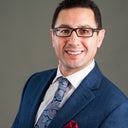*Only* correcting frontal asymmetries of the nose is just extremely difficult, and usually not very predictable. We can usually make a nose straighter, but never put it right in the middle of the face.But when there are *other* areas to work on, that helps greatly. I'll explain.You might have a very crooked septum affecting your breathing. Straightening the septum can sometimes help in straightening the appearance of the nose.Your nose is strong in its forward projection from your face. The tip can be brought back closer to your face. We call that "de-projecting" the tip, and the techniques that accomplish the de-projection can also help in straightening your nose. I see the width of the tip. That area can be addressed. The woman in the short video that I posted with this answer had the tip of her nose narrowed in her operation.Then, just overall, when a nose is being made smaller in various ways, any remaining asymmetries sit on a smaller nose, so they are smaller themselves, and thus they bother us less after surgery.How *much* to narrow the tip, or deproject the nose? We figure that out with morphs, well before surgery. I'd love for you to see some excellent professionally-designed morphs of what could possibly be done with your nose. Morphs could also help you identify what's bothering you, and help you set a goal for the rhinoplasty that's accurate for your tastes. (Side note: in my opinion, morphs should always be done by the surgeon, or he should direct an assistant as she makes the morphs. Morphs should be made with a constant eye to what actually *can* be done in surgery, for that particular nose, and only the surgeon has that information and judgment. Another aside: I also recommend that you not show morphs made by one surgeon to a different surgeon. If a surgeon makes his *own* morphs, you get to see whether he understands the important issues of your nose, and how your nose should be changed. But if you show the surgeon someone else's morphs, and he says "Of course I can make your nose look like that," then you don't really know if he fully understands, or even recognizes, the important changes shown in those morphs. And you don't know if he can make those changes during surgery.)
















